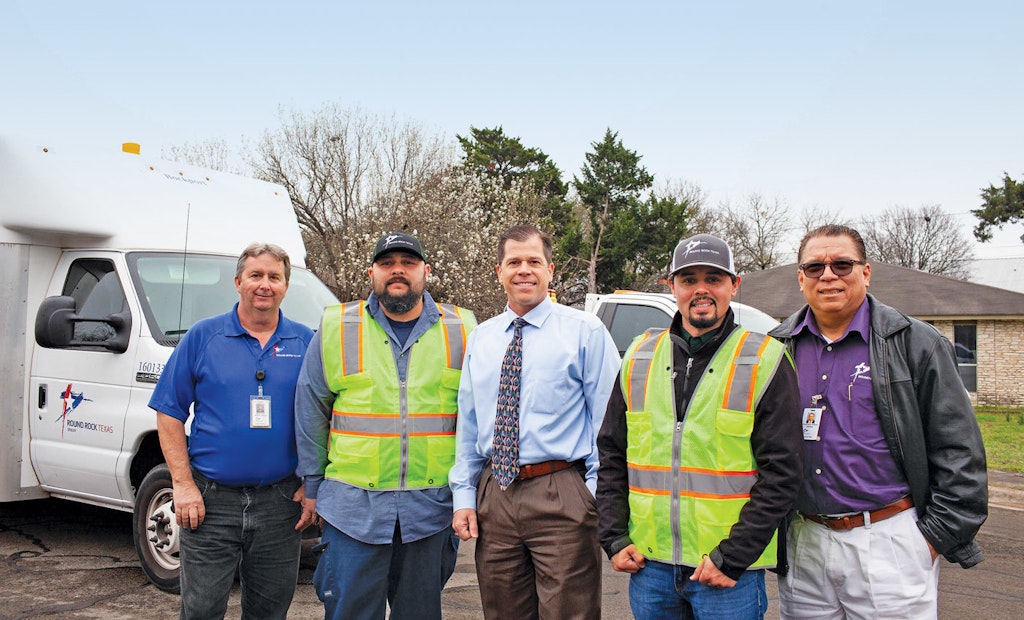
The Round Rock Utilities and Environmental Services Department team includes (from left) Mark Hurd, Mike Pompa, Michael Thane, Jose Galvez and Francisco Vicent.
The secret to infrastructure improvement while limiting debt may be as simple as two words: impact fees.
Round Rock, neighbor of Texas capital city and tech mecca Austin, has shared in some of the area’s explosive regional growth. With a current population of 115,000, it has grown 15 percent since 2010 and is projected to reach 160,000 by 2030.
Never one to settle, Michael Thane, director of the Utilities and Environmental Services Department for the city of Round Rock, is spearheading two major projects to max out the city’s water and wastewater capacity. In combination with fresh- water reduction programs like advanced metering infrastructure, conservation and water reuse, Round Rock will be on track to meet its maximum infrastructure potential, supporting 250,000 customers, by 2050.
Pay as you go
Thane summarizes the city’s financial philosophy with the phrase “pay as you go.” Except for two major regional projects, Round Rock doesn’t embark on any new infrastructure until all the money needed for its completion is in the bank.
“The pay-as-you-go philosophy means we try to build up our fund balance — in other words, our savings account — and then we utilize this money to go build infrastructure without having to issue debt,” Thane says.
The main vehicle for ensuring that the city coffers can bear the burden of any given project is a hefty impact fee for any new development.
“We don’t want the people who are living here to have to pay for the cost of expanding our treatment plants,” Thane says. “The plants are expanding because of a new developments, not because of the people who have been living here 30 years.”
They also utilize careful budgeting techniques to ensure they are meeting their capital budget goals.
“We’re very conservative in our budgeting. We estimate lower than we think we’re going to bring in to calculate our revenues,” Thane says. “We try to be as efficient as possible in order to keep our expenses down and estimate our revenues at a lower amount, so when we bring in more revenue, that extra money we make goes into the fund balance, which pays for the capital projects.
“But say we don’t sell as much water in a given year — we protect ourselves, we don’t get in this bind where we underrecovered and do not recover enough money to cover our expenses.”
On average, impact fees for water and wastewater systems are a little over $6,000 for a new house to be built. As Thane says, initially it can be a hard pill to swallow for homebuilders, but the cost is still a lot cheaper than drilling a groundwater well or putting in a septic system.
“That complaint about ‘homebuilding’s going to slow down and growth is going to stop’ doesn’t carry much weight when it comes to these impact fees,” Thane says. “Many of the other cities now have caught us. We had some of the highest impact fees in the state for a long time, with the lowest rates, and now many others have seen the benefits of impact fees, so they’ve raised theirs quite a bit, and now we’re not even the highest in just Central Texas.”
Water conservation
The city is taking a broad approach to growth, implementing new systems they hope will curb water usage, creating some cushion during expansion.
As part of the city’s ongoing master improvement plan, which is a 10-year plan updated every three years, the utility has implemented a process for nonpotable reuse.
“We treated the wastewater, then we’ve stored it instead of discharging the treated wastewater to the creek, and now we’re reusing it by sending it out to customers to use for irrigation purposes,” Thane says.
There are only about 10 reuse customers in the city at this time, but they are large-scale water irrigation customers, including a golf course, minor league baseball field and a city park, among others.
“It helps to prolong our water supply sources because you’re reusing water you’ve already paid for,” Thane says.
But the pride of the water system after its completion last year is the AMI. Despite only just reaching its apex, without the city pushing for its adoption, 18,000 of the approximate 30,000 residential customer accounts have already signed up through the online customer portal.
The last stage of AMI adoption for residential customers was completed in May 2018 — opening the online portal for customers to manage their accounts digitally. Thane hopes to have all of the residential accounts rolled over into the new system by the end of 2019.
It took seven years and $7.5 million to fully integrate AMI. They proceeded in baby steps, first installing the automatic meters, where employees could begin doing drive-by meter readings. Then the infrastructure aspect began with the addition of relay stations, allowing automatic transfer of data back to a central server. Last came the online customer portal, the final piece of the puzzle that was just implemented in 2018. Now it’s just a matter of promoting the online option so all residential customers can utilize the digital database.
“It’s a real water education, water conservation tool that if everybody uses it like we hope they will, could have a really good effect on our overall water supply,” Thane says. “It’s really going to help out our utility billing office because the customer portal allows more electronic payments, and so you have less people walking into the billing office to pay, and you have fewer people mailing in checks. You go to this electronic payment, and everything goes faster: The utility billing office will be able to operate more efficiently.”
Embracing regionalism
Although they have been very successful with their pay-as-you-go methodology, a few projects that are underway required the city to take on some amount of debt.
The reason for that necessity is in part because they are regional cooperative projects that will be depended on by more than just Round Rock.
First, with the increasingly common drought conditions in Central Texas, on top of rapid growth, many municipalities are finding a need for additional reliable water sources. As part of what they have dubbed the Brushy Creek Regional Utility Authority, Round Rock is teaming up with two other municipalities to build a deep-water intake in Lake Travis.
For Round Rock’s part, they hope this new intake will fill their water needs into the distant future, upping their capacity to the 250,000 estimated population threshold.
“All three cities have water under contract in Lake Travis, and all three cities are growing very fast, so we came together to build the infrastructure as one group,” Thane says. “It’s more cost-effective to partner together — I think we anticipated about a 30 percent savings by building one big system rather than each one building an individual system.”
The intake will pull water from deep in the lake, a little more than 120 feet below the lake-full level and near the river channel, which is the deepest part of the lake.
“It’s a drought protection project and will make sure we have water for the three cities for a long time. Just another example of regionalism. We’re constantly talking to our neighbors about working together and helping each other out,” Thane says. “That’s what’s very neat about this region: We have good relations with almost every city around us.”
It’s a $160 million project, of which Round Rock is financially responsible for approximately 29 percent. The goal is to have the intake online by 2026, with the project in the engineering design process right now.
Also on their radar is a capacity upgrade for one of the two regional wastewater treatment plants that Round Rock recently took over daily operation.
“Because the two plants are located in the city of Round Rock, it only makes sense for us to manage the operations and maintenance. It is a huge challenge, but we also know that we will be able to identify efficient ways to save money,” Thane says. “If we need some help at the regional plant on any given day, we can bring other staff from our utility, send them out there to help and then they can go back the next day to their normal jobs.”
The costs of operations and maintenance are split between the four cities based on the percentage of wastewater that each contributes.
“Operating and maintaining the regional plants will continue to be a challenge just because it’s new for us,” Thane says. “It’s important when you have other cities trusting in you. By taking over something that large, it’s important for us to deliver what we said we were going to deliver, at the best price.”
Upgrading the larger of Round Rock’s two shared regional wastewater treatment plants will take the existing overall treatment capacity from 24.5 to 33 mgd. Still under design, the project is estimated to cost about $100 million. They hope to complete it by 2022.
Fortunately, their efforts to keep debt low over time has led to a AAA bond rating, which makes it easy to obtain good loan terms when necessary for projects like these.
Delivering the best
Debt is often a necessary evil for municipalities, but Round Rock has maintained minimal debt while completing innovative projects and maximizing its system capacity for population growth.
“Our utility takes great pride in what we do, and it’s always challenging because we put the pressure on ourselves to be the best utility that we can be,” Thane says. “We want to deliver the best service at the best price, better than anybody else. We don’t have that status quo mentality.”
Every utility wants to provide great service at low rates for their customers, but doing so is often easier said than done. Round Rock’s example shows how impact fees can lighten the burden of capital improvements for citizens while allowing ambitious infrastructure expansion.
“The city has done a good job over the last 25 years by implementing impact fees and a pay-as-you-go philosophy, positioning us well with infrastructure and low water and wastewater rates, and that’s why you see so many people moving here,” Thane says. “Round Rock is a hot spot — everybody wants to come here — because if you have water and you have infrastructure in place, it makes development of properties a lot easier, and sometimes that gives us a leg up on other cities.”
Fighting a mussel infestation
Like many municipalities across the nation in recent years, Round Rock in Texas has had to deal with a proliferation of invasive species in its water sources.
“A major challenge facing our water utility is the infestation of zebra mussels in our water supply lakes. All three source lakes in the past year and a half have been identified with zebra mussels,” says Michael Thane, director of the Utilities and Environmental Services Department for the city of Round Rock. “It reduces our ability to pump water to our treatment plants.”
Zebra mussels have been an increasingly common problem for water utilities. Though not originally native to the United States, the species infested the Great Lakes region and has pushed south along the Mississippi River, even reaching as far west as Central Texas.
“Those mussels attach to metal objects, so the challenge we’re faced with is how we keep them off of our intake screens and out of our raw water pipelines,” Thane says. “We are designing a system where we’re going to inject sodium permanganate as a chemical into our raw water pipeline that will help kill the mussels.”
Even with chemical treatment, divers will have to periodically clear the intake screens of mussels, as the city cannot inject the chemical into the lakes themselves.
“The managing authorities for the lakes do not mind if we add chemicals into the pipeline, once it’s leaving the lake, but the concept of adding chemicals to the intake screens in the lake is a whole new concept that is still under consideration. Zebra mussel control is going to be a big challenge for 2019 — not only for Round Rock, but for most utilities that take water out of surface water lakes.”








